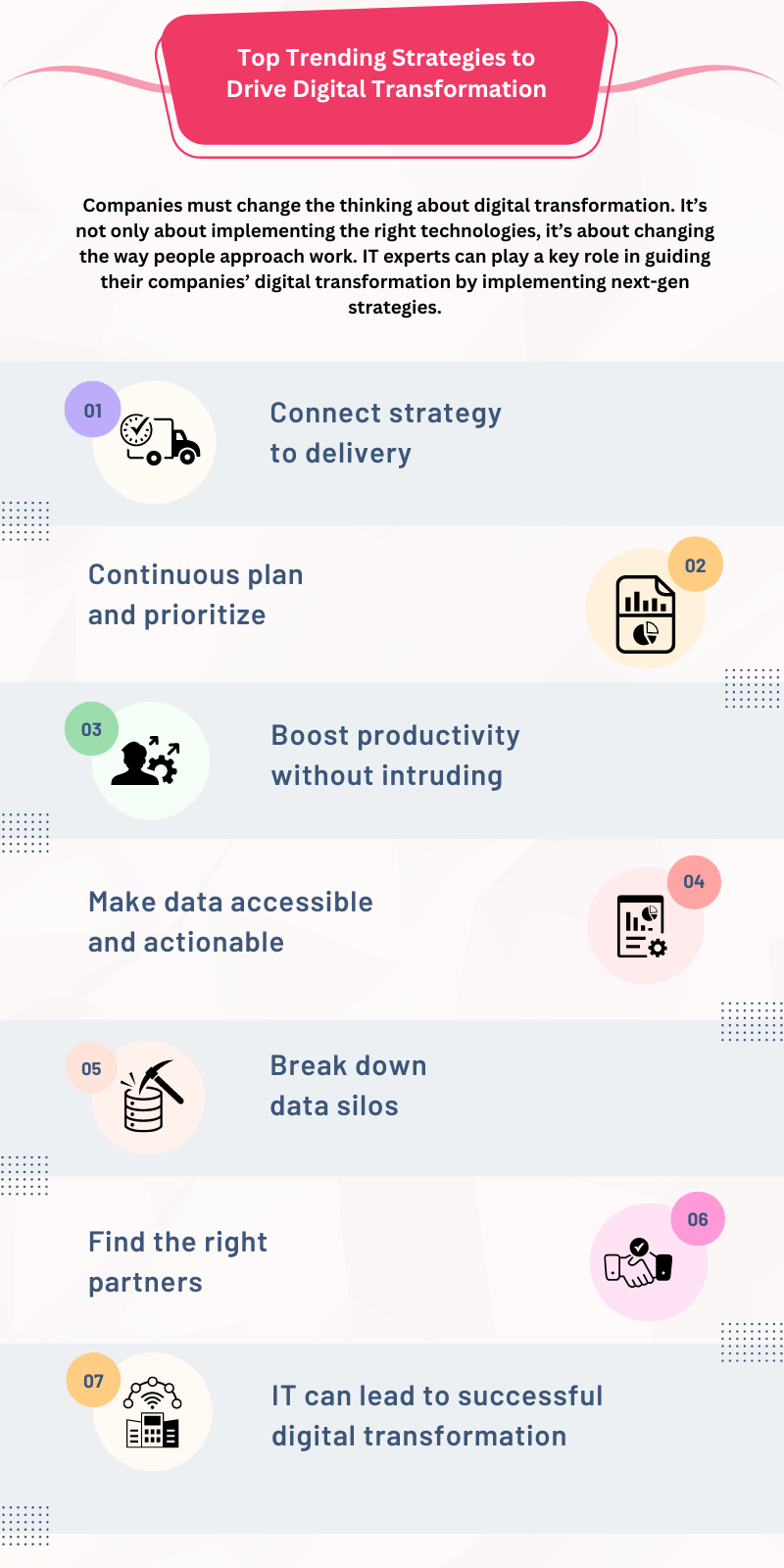Enterprise digital transformation is the implementation of next-gen digital solutions to your organization’s key business operations. It is a complete transformation to meet market demands and excel in a digital-only world. You can plan, process, execute, and achieve business strategies digitally. All the internal and external tasks of your company will be performed technologically once you invest in enterprise digital transformation from a recognized digital agency.
Multiple technologies contribute to this domain. Implementing them as per your business needs can be the next big step toward your company’s desired growth. Technologies including the Internet of Things, Artificial Intelligence, Machine Learning, Blockchain, and Cloud Computing are major elements in the digital transformation process. You just cannot survive in the competitive digital world without these technologies. Every organization is making a move towards implementing these technologies to better its workflow.
In a recent study, it was found that most industry leaders are doubling down on enterprise digital transformation investments and are growing 5x faster than competitors. This is an instrument to the growing popularity and necessity for tech-based solutions for an organization.
Tips to Implement of Enterprise Digital Transformation Strategies
1. Identify Focus Technology
The most important step is not to jump on any technology for your business transformation. First, identify the important processes. Prioritize initial efforts for quick payback. A survey revealed that customer experience, operations, innovation, and marketing strategy have a crucial role in digital transformation. Invest time to research and choose the platform and solutions that fit your budget. There’s no particular guideline for going digital, it needs an approach to meet your organization’s needs.
2. Prioritize User Experience
The ultimate objective of enterprise digital transformation solutions is to refine the user experience. To meet the demands and survive in the digital era, focus on your consumer. Plan the complete customer journey, and then check how going digital can make UX design improved and efficient. Shift regular user experience into a positive, consistent, and real-time experience. Customers prefer improved technological capabilities, ease of use, and a touch of personalization. If the experience is not engaging, they’ll simply move elsewhere. More than 40% of business revenue comes from customer targeting and engagement use cases.
3. Build a Digital Roadmap
Digital transformation services are not only focused on implementing the latest technologies, rather it’s a journey that needs an explicit vision for how these digital tools will be implemented. The complete enterprise digital transformation process must be well-thought-out. Check all the boxes and make sure you consider:
- IT budget
- Overall brand strategy
- Organizational impact
- Baseline metrics
- Operational costs
- Projected ROI
- Market research
- Expected outcomes
- Performance expectations
- Resource and technology requirements
Going back to the digital maturity, it is crucial to see where your organization lies on the scale in order to fully plan out your strategy.
4. Modify Operations
Optimizing business operations is essential, but even more so when creating digital transformation strategies. One of the key strategies is to understand and assess your team’s abilities and strengths. Should they require additional support, this is a great stage to obtain it. The next strategy is to set a clear planning approach and explicit procedures, lowering the time spent on misunderstandings. By executing projects with the right strategy, the team will be more efficient and creative, focusing on innovations and less on roadblocks. Continue to share these plans with stakeholders, including all regulatory best practices.
5. Constantly Make Adjustments
No matter how relevant your digital transformation service is, there is always a scope to improve. As the company needs transformation, these changes are important, so having timely evaluations is crucial to long-term success. Collecting data is essential, but only if you take regular action. Sharing metrics with specific teams is crucial for growth. A business prioritizing transparency in every department experience positive outcome in comparison to competitors.
Benefits of Enterprise Digital Transformation for Business
1. Real-Time Data Collection
Most businesses operate by gathering large volumes of data, but the real advantage is to get key insights to drive the business ahead. Digital transformation solutions create a strategy to gather the appropriate data and include it for business intelligence. It builds a process that an organization can use to translate raw data into crucial insights. This process creates a single view of the customer journey, production, operations, finance, and business opportunities.
2. Personalized Customer Experience
Expectations of customers are always high when it is to the experience. Customers have multiple choices, low prices, and fast delivery service providers. Customer experience is the most important battlefield. According to reports over two-thirds of brands are competing mostly on improving customer experience. By the end of 2022, the number can reach 71%. Customer experience has emerged as the key element of sustainable business growth. It has been observed that even a single point of growth in user experience can results in millions of dollars in profit.
3. Higher Profits
Companies that opt for digital transformation consulting improve efficiency and business profitability. Analyze these results mentioned by the experts from business insights:
- 80% of businesses with enterprise digital transformation report higher profits.
- 85% say they have seen a surge in their market share.
- On average, brands have achieved 33% higher revenue growth than competitors.
4. Improves Employees Skills
As companies adopt the latest technologies for business growth, employees need a continuous update in their skill set to sync with the market trends. In this regard, the skills of the employees will be improved. With an improved skill set of the employees, it builds agility and better communication among all the departments in the organization. In addition, the work quality is significantly improved.
5. Encourages Digital Culture
Having a digitized business environment enhances productivity and it supports employees to smoothly adapt to any technological changes. Regarding skill set enhancement, a digital environment encourages continuous learning of the employees. Moreover, it keeps the employees motivated and agile at all times.
Enterprise Digital Transformation Challenges in 2023
While digital transformation services offer unique opportunities for business organizations, it also forces critical thinking that is crucial to your business.
1. Lack of Change Management Strategy
Organizations with deep change management strategies are more likely to meet digital transformation objectives. Having strong change management is crucial for any organization’s success. A lack of a change strategy sets up any new project or implementation plan.
A proper change management strategy comprises planning a project by identifying the core causes of issues as well as building relationships with all stakeholders and employees.
2. Complex Software & Technology
Enterprise software is highly complex. New technologies are intimidating. This is a huge challenge for business organizations undergoing digital transformation both from an implementation and data integration point.
Leaders should consider this when in the early stages of a transformation project, and seek out the most intuitive, integrated systems.
3. Ever-Changing Customer Needs
Customer needs continuously evolve and the COVID pandemic accelerated this. Analyze what are the requirements of customers. That changes as the world evolves and industries grow.
Digital transformation is not a simple job, and intensive transformation takes years to complete. What happens if, during that tenor, your customer needs change? Evolution of customer concern will occur. Don’t get surprised, and plan to be agile when you are focused on implementing new digital technologies.
4. Lack of Crucial IT Skills
To be at the top of the transformation efforts, you’ll require a skilled, high-performing IT team. And that is challenging when putting together the current tech worker shortage. As per an enterprise study, 55% of organizations revealed that they’re not able to achieve their digital transformation goals because of a lack of technically experienced employees.
The challenges for organizations consist of a lack of skill sets in cybersecurity, application architecture, software integration, data analytics, and data migration. Organizations that lack IT professionals can address this challenge by outsourcing digital transformation services. This will give them timely help regarding implementation and migration gaps.
5. Security Concerns
Several enterprise organizations operating in data-sensitive industries come across privacy and security concerns. And that is valid. Most of the digital transformation activities involve cloud solutions, as well as integrating all data into one centralized place.
Of course, this drives a higher number of cyber-attacks stealing customer records and company data. Online attacks identify possible system vulnerabilities, poor setups, and naive users. Make sure to create a plan in place to properly eliminate these threats before they happen. Bring in a cyber-security expert to help identify possible weaknesses in your defense.
Enterprise Digital Transformation Trends to Implement in 2023
1. Automation across the Board
There’s no doubt that automation is required in every possible aspect of the business phase. In short, automation is crucial to digital transformation, because it’s the easiest process to reach scalability, efficiency, and reduce costs. One aspect that has seen a significant boost from automation is the AIOps sector.
2. Cybersecurity
With the advancement of 5G and IoT devices, cybersecurity plays at the forefront of business operations and digital transformation. The latest survey of IBM revealed more than 4,000 US, EU, and Chinese businesses showed that cyber security technologies was the most popular use case for digital transformation.
Business brands prioritize machine learning and artificial intelligence to find malware. Cybersecurity is often considered the most important stage for transformation and will continue to play a big role in 2023. Business giants are already implementing these technologies for their organization requirements too.
3. Growth of Artificial Intelligence
If automation is an important part of digital transformation services, artificial intelligence solutions (AI) are the backbone of automation itself. It’s not new to know that a majority of systems and solutions under digital transformation are AI-based. Cybersecurity and analytics software are all AI-supported. Because of this, business organizations are taking a keen interest in AI to gain competitive benefits.
AI can support business security, decision-making, marketing, and customer support. Experts predicted the market will grow 54% year-to-year in the next few years. Expect big gains in 2023.
4. Agility as a Top Priority
As mentioned earlier, security is a growing concern for business enterprises. This growing concern is prompting businesses to work on the fact that agility is crucial to fix hacking attacks. Companies are looking for a mechanism where they’re not preparing for ‘what if’ situations, but they are building actual plan that is dynamic and will stop them from suffering. Beyond cyber-security, agility is a key foundation of multiple digital transformations altogether.
5. Cloud Technology
Cloud-based technologies and solutions are becoming highly crucial due to their exceptional benefits, comprising cost savings, scalability, and ease of use. Several organizations are making a move from conventional on-premises software to cloud-based solutions. As they are more efficient and cost-effective means to run business applications. Moreover, cloud computing-based services offer improved cyber-security features and keep data safe.
6. Blockchain
Blockchain is a next-gen technology that can transform the way people run businesses. It can transform strategies for how companies will engage target audiences. Blockchain has features to boost consumer service and improve connectivity for consumers. In addition, it can make companies stay transparent and personalize all sorts of business-customer experiences.
Today, Blockchain technology isn’t only limited to financial environments. There are multiple examples of Blockchain technologies being implemented in diverse industries for unique applications. It is highly popular outside the finance domain including vote polling, HR processes, and manufacturing.
The Key Elements of Enterprise Digital Transformation
In this section, we will talk about the key elements of digital transformation. Although their implementation will appear different for every organization, there are some common elements that every successful digital transformation needs.
1. Customer Experience
Digital transformation drives customer experience toward brand growth. Businesses across sectors are making optimum use of digital platforms and technologies to gain insights. Communicating with customers directly, and inherently transforming the digital customer experience. A Harvard Business Report found that 40% of businesses named customer experience for their digital transformations.
In the last few years, there has been a significant surge in new communication channels, e-commerce shopping, and personalized experience across industries. Each of these advancements focuses on unique, better digital customer experiences.
2. Data
One of the key reasons to adopt digital transformation is to remove the pain points of your business. But how to identify these pain points? Data integration and data analytics can help identify them. Several times, businesses don’t focus on their data while building enterprise digital transformation strategies. This is not the right way to move ahead.
If you don’t study data, you may miss out on the challenges that your customers have to address. Data-driven insights can assist your team find relevant solutions to problems, thus creating a digital transformation strategy and process.
3. Operational Processes
Digitization of processes reduces the number of resources and time required for maintaining operations. Companies are investing in digital tools and platforms for improving collaboration on the go and streamlining their operation. For example, several companies have implemented RPA to simplify their back-office processes, comprising legal and accounting examples.
4. Business Model
Modification of business models also works as a key element of digital transformation. While several conventional traditional businesses are moving to digital platforms to change their service offerings. Countless other businesses are adding new digital-centric models to their service offerings.
5. Technologies
Identifying relevant technologies for your business is one of the major elements of digital transformation. Implementing new technologies in your company needs a lot of capital investment. Thus, it must be performed carefully and correctly. Whether you are dealing with application modernization, legacy systems updates, or implementation of completely new digital systems, you must focus on the most fitting technology.
Steps to Create Enterprise Digital Transformation Strategy
A digital transformation strategy is a set of actions implemented for driving digital transformation initiatives forward. Your strategy defines what business goals and objectives you want to achieve in the next few years. An effective digital transformation solution will help build a framework to follow throughout the transformation phase.
Here are the steps to consider when implementing a digital transformation strategy:
1. Identify Business Goals
A digital transformation strategy should define what your business goals are, and what steps are required to achieve them. As digital transformation strategy is different for every organization, it’s crucial to note that the objectives of each organization differ as well.
- How to increase customer engagement?
- Can you create a cost-effective and more efficient business model?
- Do you have the plan to gather data and insight?
Answering these questions will identify areas within your plan that need immediate attention, or which components should be addressed first.
2. Get Businesspeople on Board
For a successful enterprise digital transformation strategy, you need the support of people. The first step is to get proper funds for your efforts. Having a professional executive on board makes it simple to start the digital transformation planning process.
Listen to the concerns of your employees and team members. If you can address their problems, they will happily be part of your transformation journey. Make sure your employees know the benefits of digital transformation for your business. You can also organize meetings with stakeholders to address key issues before you begin.
3. Build new Business Processes
Your regular business approach may not work with your digital transformation initiative. Building and adopting new processes can bring success to your organization.
For some organizations, an enterprise digital transformation plan will need a complete transformation in processes. To perform this change, it’s important to ensure that everyone, understands the updates, and knows who is accountable for what, and what systems are being implemented.
4. Choose Technology Wisely
Make sure to invest in the technology that supports your cause of optimizing processes. Choose a technology that meets your business needs and helps scale your overall organization growth. Ultimately, the technology you choose should align with your goals and help your organization meet its business objectives.
5. Allocate Time and Budget
Your digital transformation must work like a series of projects the company plans on the undertaking. This means both the time and money required are for success. Perform regular meetings to go through every issue that arises during the transformation journey.
Set a separate budget to implement the digital transformation process and analyze the impact on business resources. Also, define a process for performing changes in allocated budgets. Analyze what impact occurs on your team and external personnel with the transformation.
6. Choose Technology Partner
It’s highly essential to choose the right technology partner for the successful implementation of the digital transformation process. You should consult a trusted digital transformation service provider with the relevant expertise and knowledge in transformation services. The professionals will offer next-gen digital solutions and technologies that will drive your business transformation journey and help scale your business without any trouble.
7. Scale and Transform
By now, your company will start to see results. Make the best use of this success to gain momentum and grow your business. There will always be changing customer needs and advanced technologies that need to be accounted for. Take the momentum built up from your achievements and address the new needs to make your company as competitive as possible.
Wrapping Up
The advantages of digital transformation are more than the ones discussed above in the blog post. For some business organizations, the gains they derive after the implementation are more than what had been anticipated. It is recommended that all enterprises integrate advanced technologies into their day-to-day business operation. While digital transformation may be a challenge for some companies initially the long-term business benefits are remarkable. Digital transformation companies are always available to assist in case you are new to the change.
Frequently Asked Questions
1. What is digital transformation?
A digital transformation is the use of digital technologies to reinvent the way a company does business, to be more productive, agile, and responsive, in order to deliver higher value to customers at lower cost. Few areas of a business can benefit from digitization more than the supply chain.
2. How does DevOps work?
The DevOps model enables the development and operations teams to merge and operate as a single team. Under this model, developers work across the entire software lifecycle, from development and test to deployment. DevOps enables organizations to improve products faster than teams using traditional software development practices.
3. How does digital transformation benefit my organization?
Our enterprise digital transformation empowers you to redesign your business models, products, and customer experiences to drive better value. It helps you reinvent and manage your business-critical processes with new and innovative ways of working. Lastly, it simplifies, modernizes, and secures the IT infrastructure and business systems that are the backbone of your organization.
4. What makes digital transformation successful?
For digital transformation services to be fruitful, they should saturate through each group and division. The cycle requires an agile methodology as well as arrangement and comprehension of how data, plan, and technology will affect them across groups — HR, finance, marketing, advertising, and even the product.
5. What are the 4 fundamental areas of Digital Transformation Services?
The 4 principal areas are:
- Process Transformation.
- Business Model Transformation.
- Domain Transformation.
- Cultural/Organizational Transformation.
6. What is a digital transformation roadmap?
A digital transformation roadmap paves the path for a successful digital business transformation. It begins with an assessment of the organization’s current digital deployments and gives a step-by-step plan on how to implement digital transformation services aligned with the company’s long-term vision. Avail of our digital transformation services to build effective digital transformation roadmaps with the help of our digital transformation consultants.
7. What is the purpose of digital transformation?
Enterprise digital transformation helps companies break away from complex legacy systems so adapting to change is easier. Introducing new technologies, such as cloud or IoT, can free data from silos so employees and teams can easily shift to new systems and processes.



























